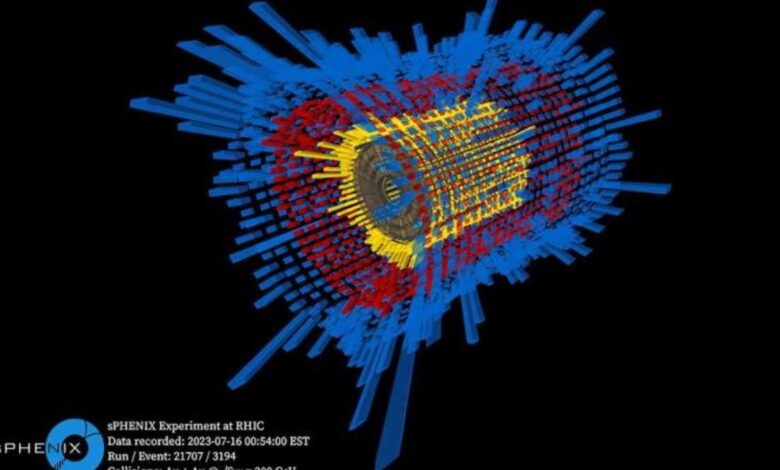sPHENIX Reveals First Quark-Gluon Plasma Study Results

sPHENIX at RHIC: Unveiling the Secrets of Quark-Gluon Plasma
The sPHENIX detector at the Relativistic Heavy Ion Collider (RHIC) at Brookhaven National Laboratory has achieved a significant milestone by reporting its initial physics measurements from gold-ion collisions. This marks a crucial step forward in the exploration of the quark-gluon plasma (QGP), a state of matter believed to have existed in the universe’s infancy.
Designed specifically for heavy-ion experiments, sPHENIX meticulously recorded the trajectories and energies of thousands of charged particles emanating from head-on collisions of gold ions. These preliminary findings validate the detector’s performance and establish a solid groundwork for its primary mission: to delve deeper into the properties and behavior of the QGP.
Validating Detector Performance
The initial measurements focused on verifying fundamental collision characteristics. By analyzing the distribution and energy of the produced particles, researchers confirmed that sPHENIX is operating as expected. This validation is essential for the subsequent, more complex investigations into the QGP.
The Quest for Quark-Gluon Plasma
But what exactly is this quark-gluon plasma that scientists are so eager to study? According to theoretical models and experimental evidence, the QGP is an exotic state of matter composed of free quarks and gluons – the fundamental building blocks of protons and neutrons. This state is thought to have prevailed in the first few microseconds after the Big Bang, when the universe was incredibly hot and dense.
To recreate these extreme conditions in the laboratory, physicists collide heavy nuclei, such as gold ions, at near-light speeds. These collisions generate a minuscule fireball where nuclear matter undergoes a phase transition, effectively “melting” into the QGP. sPHENIX, an advanced upgrade of Brookhaven’s previous PHENIX detector, was conceived and constructed to meticulously probe these extreme conditions.
Key Findings from Initial Collisions
One of the key findings from the initial sPHENIX measurements is that head-on (central) gold-gold collisions produce approximately ten times more charged particles and energy compared to glancing (peripheral) collisions. This observation aligns with earlier results obtained at RHIC and further corroborates the detector’s proper functioning.
With this foundational understanding in place, researchers are now poised to investigate the QGP’s rarest and most informative probes: fully reconstructed jets. Jets are sprays of particles produced when quarks or gluons are ejected from the collision zone. By studying how these jets interact with the QGP, scientists can gain insights into how quarks and gluons lose energy as they traverse the plasma.
Jet Quenching: A Window into QGP Properties
This phenomenon, known as jet quenching, is a key indicator of the QGP’s properties. The degree to which jets are suppressed or modified as they pass through the plasma provides valuable information about the plasma’s density, temperature, and transport properties.
The Broader Context: RHIC, LHC, and the Future of QGP Research
The exploration of the quark-gluon plasma is not confined to a single experiment or facility. RHIC’s final run of gold-ion collisions in 2025 will leverage the full potential of all its detectors, including sPHENIX. Concurrently, the Large Hadron Collider (LHC) at CERN collides lead nuclei at significantly higher energies. The ALICE, ATLAS, and CMS experiments at the LHC have also observed QGP-related phenomena, such as jet quenching.
These complementary efforts at RHIC and the LHC are crucial for obtaining a comprehensive understanding of the QGP. By probing different energy regimes and collision systems, researchers can piece together a more complete picture of this exotic state of matter.
sPHENIX: A Microscope for the QGP
In the next phase of its research program, sPHENIX will utilize energetic jets as a “microscope” to scrutinize the QGP’s internal structure. By comparing the energy loss of heavy-quark jets (containing charm or bottom quarks) with that of light-quark jets (containing up or down quarks), scientists can test whether the plasma behaves as a smooth fluid or exhibits clumpiness.
This comparison is based on the theoretical prediction that heavy quarks, due to their larger mass, should interact differently with the QGP than light quarks. Any observed differences in energy loss patterns can provide insights into the plasma’s microscopic properties.
Collaboration and the Excitement of Discovery
As one of the co-spokespersons aptly stated, the initial measurements from sPHENIX “establish the basis” for the experiment’s QGP program and signal “the start of a very exciting chapter” of discovery. The collaborative spirit and the pursuit of fundamental knowledge drive the researchers involved in this endeavor.
| Property | Description |
|---|---|
| Temperature | Extremely high, exceeding trillions of degrees Celsius, hot enough to break down protons and neutrons into their constituent quarks and gluons. |
| Density | Exceptionally dense, several times denser than normal nuclear matter, creating an environment where quarks and gluons are no longer confined within individual particles. |
| Lifetime | Extremely short-lived, existing for only a fraction of a second (microseconds), posing significant challenges for experimental detection and characterization. |
| Interaction | Characterized by strong interactions between quarks and gluons, leading to phenomena such as jet quenching and collective flow, which provide insights into the plasma’s properties. |
| Experimental Probes | High-energy collisions of heavy ions (e.g., gold, lead) at relativistic speeds, creating conditions suitable for QGP formation; detection and analysis of particles produced in these collisions (e.g., photons, leptons, hadrons) to infer QGP properties. |
| Theoretical Models | Quantum Chromodynamics (QCD) provides the theoretical framework for understanding QGP; lattice QCD calculations and hydrodynamic models are used to simulate QGP behavior and predict experimental observables. |
| Significance | Offers insights into the fundamental nature of matter and the early universe; provides a testing ground for QCD and other theoretical models; has potential applications in nuclear physics, astrophysics, and cosmology. |




